Looking for New Roles |
|||||||
Many of the buildings that remained after the bombing were dismantled or disappeared in the process of recovery due to normal deterioration or site redevelopment.
In response, city residents began to request that some of the A-bombed buildings be preserved. In March 1990, the City Council passed a resolution that stated, "These historical assets should be passed down to future generations of Hiroshima residents." In 1993 the city of Hiroshima established guidelines for preserving in perpetuity buildings damaged by the atomic bomb. As a result, surviving buildings and structures located within five kilometers of the hypocenter have been registered in a special ledger. Owners have been asked to help preserve the buildings, and subsidies are provided for preservation projects. Three buildings with new missions as A-bomb witnesses are presented here. |
|||||||
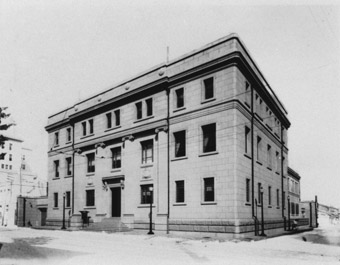 Bank of Japan Hiroshima Branch when completed. 1936.
Bank of Japan Hiroshima Branch when completed. 1936.Courtesy of Shimizu Corporation Hiroshima Branch  The third floor was completely burned, but structural damage was minimal. Services resumed two days after the bombing.
The third floor was completely burned, but structural damage was minimal. Services resumed two days after the bombing.Around November 1945. Taken by Toshio Kawamoto Courtesy of the Association of the Photographers of the Atomic (Bomb) Destruction of Hiroshima |
Bank of Japan Hiroshima Branch
Just a short two days later on August 8, the bank resumed services. Temporary offices were also set up for other financial institutions that could no longer operate because of the disaster. Financially, this bank underpinned Hiroshima's recovery. In 1992 the Hiroshima Branch relocated to Moto-machi in Naka-ku. Then, starting in 2000, the city of Hiroshima received a free lease. Before full-fledged utilization, it has become a venue for local residents’ cultural activities. 
* Location: 5-21 Fukuro-machi, Naka-ku * Distance from hypocenter: 380 meters * Name at time of bombing: Bank of Japan Hiroshima Branch * Structure/number of stories: Reinforced concrete, three stories with basement floor * Completed: 1936 * Name when completed: Bank of Japan Hiroshima Branch * Current status: Managed by city of Hiroshima. Before full-fledged utilization, a place for presentations of cultural activities. 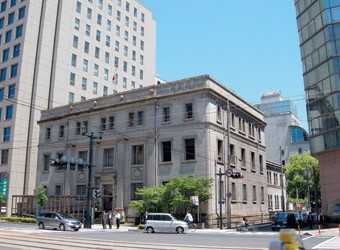 The only A-bombed structure on Rijo-dori Avenue that retains its appearance. May 2008. |
||||||
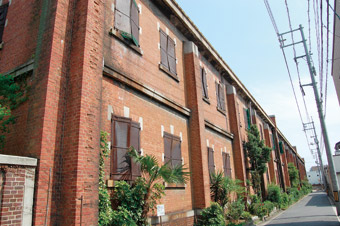 Deformed iron doors reveal the power of the blast.
Deformed iron doors reveal the power of the blast. May 2008. 
* Location: 2-4-60 Deshio, Minami-ku * Distance from hypocenter: 2,670 meters * Name at time of bombing: Hiroshima Army Clothing Depot * Structure/number of stories: Reinforced concrete/brick, two stories * Completed: 1913 * Name when completed: Hiroshima Army Clothing Depot * Current status: Preservation and use under consideration |
Former Nippon Express Deshio warehouse
The Clothing Depot produced, repaired, stored, and supplied clothing and accessories that soldiers wore, such as military uniforms, shoes, and caps. It included a large-scale manufacturing and repair factory, as well as warehouses for storage and distribution. Four reinforced-concrete warehouses still exist. The atomic bomb severely damaged the roof, but the depot escaped the fire. The deformed iron doors attest to the power of the blast. Shortly after the bombing, the depot was used as a temporary relief station, where many bomb victims were accommodated.
Trousers, gaiters and rubber-soled sock worn by Yoshiharu Kinoshita Yoshiharu Kinoshita (then, 13) was a first-year student at Sanyo Technical School and was performing building demolition work in Zakoba-cho, 1,200 meters from the hypocenter, when the A-bomb was dropped. His father Hawaichi (then, 47) hurried home from a business trip and found his son’s corpse on August 7 at the Hiroshima Army Clothing Depot in Deshio-cho. Yoshiharu’s horribly burned body was covered with bandages, and Hawaichi recognized him only by the nametag attached to his waist. Hawaichi carried the body home on a cart and cremated it. Donated by Katsuyuki Kinoshita |
||||||
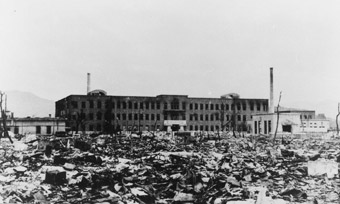 Remaining shell of the fire-gutted main building, Hiroshima University of Literature and Science. Around end of 1945.
Remaining shell of the fire-gutted main building, Hiroshima University of Literature and Science. Around end of 1945.Taken by Toshio Kawamoto Courtesy of the Association of the Photographers of the Atomic (Bomb) Destruction of Hiroshima  * Location: 1-1-89 Higashi-senda-machi, Naka-ku * Distance from hypocenter: 1,420 meters * Name at time of bombing: Hiroshima University of Literature and Science (Chugoku District Governor General) * Structure/number of stories: Reinforced concrete, three stories * Completed: 1931 * Name when completed: Hiroshima University of Literature and Science Main Building * Current status: Preservation as educational facility being explored. |
Former Faculty of Science Building No. 1 at Hiroshima University
After the bombing, only the outer shell of the main building remained. The interior was completely gutted by fire. Since the great majority of students and teachers had been mobilized to Japan Steel Works in Mukainada and other factories, they were not on the grounds at the time. However, some of the science students and Southeast Asian Foreign Students fell victim to the bomb.
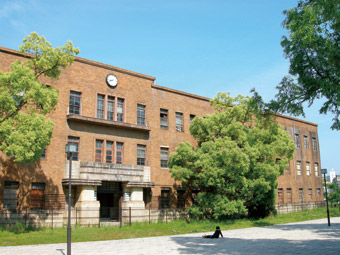 Hiroshima University's former Faculty of Science Building No. 1, as seen from a walkway called "Morito Road."
Hiroshima University's former Faculty of Science Building No. 1, as seen from a walkway called "Morito Road." May 2008. |
||||||



